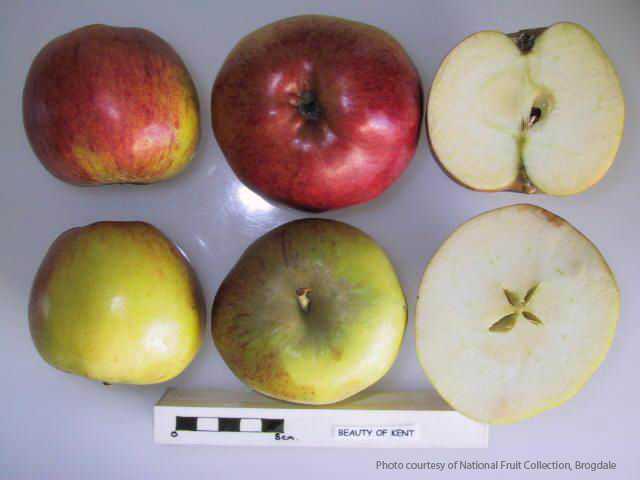Pomiferous
Welcome to the world's most extensive apples (pommes) database.
Information on over 7,000 apples is available here, all carefully researched and provided in a way that is easy to navigate.
Beauty of Kent

type: Culinary, Pie, Sauce
synonyms: Countess of Warwick, Gadd's Seedling, Kentish Beauty, Kentish Broading, Kentish Pippin (this is also a synonym for Colonel Vaughan ), Wooling's Favourite, Worling's Favourite. Pomologist Robert Hogg suggests that this may be the Rambour Franc . Not the same as Flower of Kent .
summary: A large, attractive, sharp-flavoured cooking apple, favoured for apple sauce. In pies and tarts, the cooked slices turn lemon yellow.
identification: Large to very large, round-conic tending to conic; wide and flat at the base and narrowing to the apex, prominent ridges, often lopsided. Greenish yellow base colour over which is a bright red blush marked with broken stripes. The stem is short and set in a wide, deep cavity which is usually russetted. The calyx is small and closed, set in a shallow, puckered basin surrounded by an irregular crown.
characteristics: Flesh is yellowish, coarse-grained, tender, juicy and sweet-sharp. Wonderful aromas which develop after the apple has been in storage for a few weeks.
origins: First recorded in 1770 and thought to have originated in Kent (U.K.), though there is no record of its parentage. William Forsyth mentions it in his 1824 edition of "Treatise on the Culture and "Management of Fruit Trees." Brompton Park Nurseries started to carry it in 1820.
cultivation: Moderately vigorous, upright spreading spur-bearer. Precocious.
cold storage: Keeps up to four months.
vulnerabilities: Susceptible to canker when grown in moist conditions.
harvest: Ripens late in the fourth period or beginning of the fifth.
pollination group: D
pollination peak: 12
ploidism: Triploid. Produces sterile pollen. Cannot fertilize itself nor other apple trees. Needs a nearby source of compatible pollen to produce fruit.
cold storage weeks: 16
harvest period: 4
Donate a cider?
©2016-2021 Pomiferous.com. All rights reserved